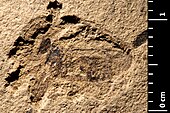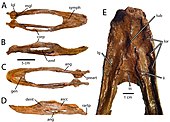Plants
Angiosperms
| Name | Novelty | Status | Authors | Age | Unit | Location | Notes | Images |
|---|---|---|---|---|---|---|---|---|
Sp nov | valid | new generic placement of Simaroubites eocenica | ||||||
Sp nov | valid | Eucommia species, found across Western North America |  | |||||
Sp nov. | nomen nudum | A golden larch species, |  | |||||
Sp nov | jr synonym | A walnut relative. | ||||||




